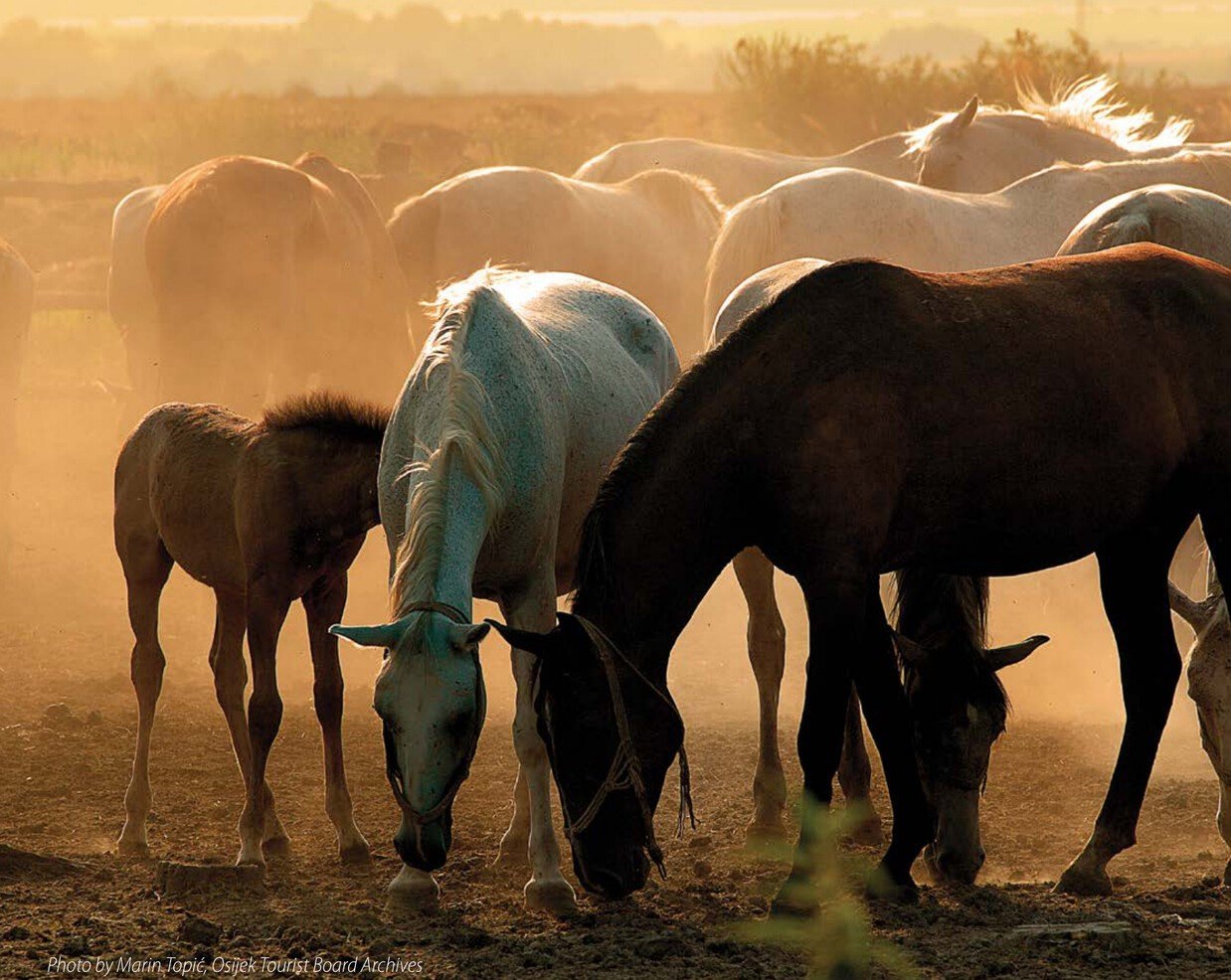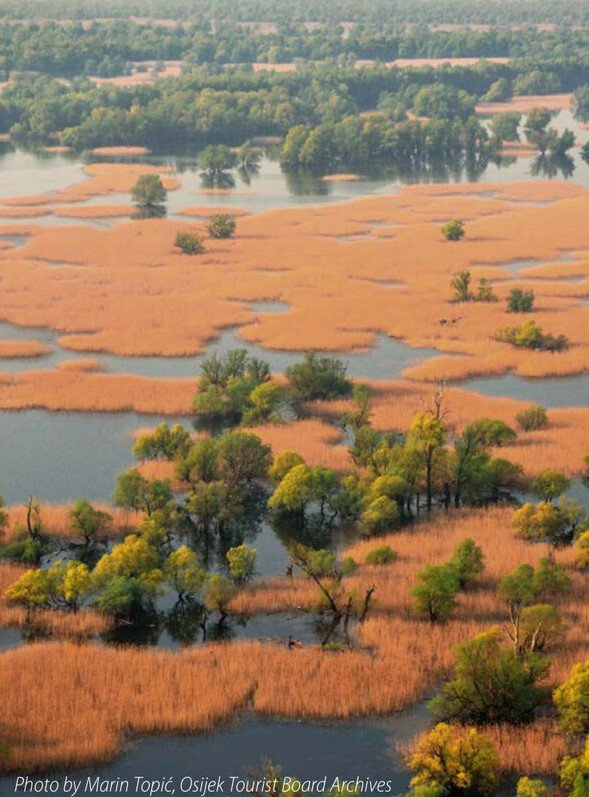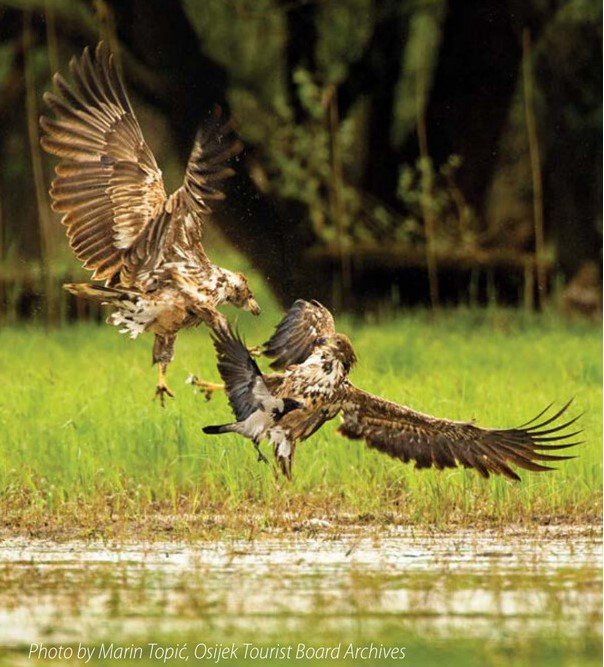Powerful Nature - Kopački rit
Just 10km northeast of Osijek, Kopački rit is one of the largest areas of wetland in Europe, and is something of a paradise for wading birds and their admirers. Declared a Nature Reserve (park prirode) in 1976, this 23000-hectare expanse of lakes, reeds, woodland and pasture is criss-crossed by dyke-top roads, making it easily accessible to the day-tripper.
Kopački rit owes its uniquely soggy character to seasonal flooding, caused (usually in spring and autumn) when excess rainwater slows up the nearby Drava and Danube rivers, which begin to overflow their banks. When this happens, large areas of Kopački rit can remain under water for weeks or months, creating the perfect haven for water creatures and birdlife. There are also two permanent lakes, Sakadaš and Kopačko, each surrounded by reedy vegetation. Semi-sunken forests of white willow thrive in the low-lying parts of Kopački rit, while poplar, oak and elm cover the higher ground. The lakes support a huge population of carp, pike, catfish and perch, alongside an abundance of frogs, snails and insects. During the course of the year Kopački rit might be visited by as many as 285 bird species. Of these, 141 species nest here regularly, the rest are spring and summer migrants. It’s the fish-eating birds that flourish most, with herons, cormorants, white-tailed sea eagles and egrets congregating around lakes Sakadaš and Kopačko.
by Goran Šafarek
The main entrance to the Reserve is at the Visitors' Centre (Prijemni centar), a traditional-style thatched hut just north of the village of Kopačevo, where you pay an entrance fee and receive an English-language information leaflet. The park is easy to get to: if you’re driving, head north from Osijek as far as the village of Bilje, turn right at the main crossroads, and follow the signs to “Park prirode Kopački rit”. There’s a cycle path running alongside the Osijek-Bilje road, making it a pleasant two-wheel jaunt. Those with no wheels whatsoever will have to content themselves with catching an Osijek-Bilje bus (every 30-50 min from Vukovarska cesta) and walking the remaining 4km to the Visitors' Centre.
Once beyond the Visitors' Centre you’re free to explore the Reserve on your own, proceeding along the eastbound dyke for 2km before arriving at the shores of Lake Sakadaš, site of a partially sunken forest where you’re likely to spot cormorants and herons.
From here you really need a car to get the best out of the place. About 8km north of Lake Sakadaš are the oak forests of Tikveš, thronging with wild boar, deer, and secretive black storks. In the middle of the forest is the palatial, red-brick Tikveš Hunting Lodge (Dvorac Tikveš), built for Archduke Franz Ferdinand in the nineteenth century, taken over by the Serbian royal family after World War I, and subsequently used by communist leader Josip Broz Tito. Perhaps appropriately for a location long associated with spraying the local fauna with gunshot, Tikveš now hosts conservation-oriented seminars organized by the European Environmental Centre (Europski centar za okoliš). The area west of Tikveš is largely taken up with meadowland and commercial fish-breeding ponds. Returning towards the Visitor's Centre this way you’ll pass the Kormoran restaurant, famous for carp roasted on a stick. The restaurant has got a lovely rustic interior, although it can get packed with coach parties at times.


By far the best way to see the park is to take a boat trip or opt for a jeep tour with a local guide. It’s important to ring the visitor’s centre to enquire about these in advance rather than just turning up on spec – the boat trips in particular don’t depart at a regular time every day of the week. The boat trip on Orao I (“Eagle One”) goes along Lake Sakadaš along the Čonakut canal to Lake Kopačko. Along the route you’ll see sunken forests of white willow, crowded in spring with cormorants and geese and in autumn with migrating ducks. Additional attractions in the vicinity of the reserve include the village of Kopačevo just southeast of the Visitor’s Centre. It’s a wonderfully preserved example of a typical Slavonian settlement, with neat rows of picturesque single-storey farmhouses, many with strings of red paprika hanging outside to dry. The Zelena Žaba restaurant in Kopačevo is one of the best places in the region to eat fiš perkelt, the dangerously spiced stew comprising huge chunks of catfish or pike-perch.
Heading back to Osijek via Bilje you can’t fail to notice the handsome ochre palace at the eastern end of Bilje village, built at the end of the 17th century to serve as a hunting lodge for the greatest of the Austrian army’s commanders, Prince Eugene of Savoy. The palace is now occupied by the administration offices of the Kopački rit Nature Reserve, but you’re free to stroll through the main gate and admire the beautifully proportioned courtyard.





Comments